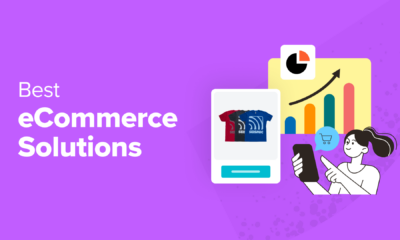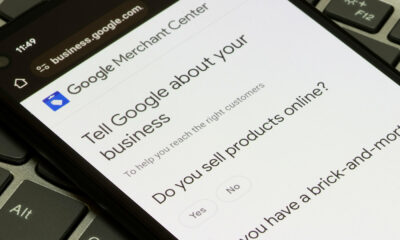MARKETING
Overview of the Best Payment Solutions for SMBs

Small business owners are always looking for the best payment solutions they can find. This is because payment solutions are one of the most important aspects of any commercial business.
In this article, we will take a look at the most popular payment methods and tools, including merchant accounts, e-commerce payments, and more.
10 Best Payment Solutions for SMBs
There are many payment solutions for small business owners looking to build profitable brands; whatever the goal may be, merchants need to make sure they can get it done quickly and cheaply.
Here are some of the best options that you can choose from to optimize your financial operations:
1. Merchant accounts
Businesses of all sizes use merchant accounts for e-commerce payments, phone orders, internet charges, donations, retail purchases, and more. The convenience lets you provide your customer with places on your website to enter information about what they want to buy or donate.
In addition, you must have a merchant account to accept credit cards on your website, which provides additional security and privacy benefits thanks to SSL encryption. A merchant account can also process payments through a mobile phone for even more convenience.
2. E-commerce payments
Another service many people turn to is e-commerce payments. They allow business owners to have a professional website that integrates secure transactions and automated checkout safely within the existing platform you use every day.
Stripe, for instance, provides a solution you can quickly integrate into websites and mobile apps. It’s easy to get started on the site by setting up your company profile and then creating forms that collect user data or accept orders while processing card information or invoices from users who are ready to buy something without going through separate shopping carts or payment pages.
3. PayPal
For 12 years, PayPal has been one of the go-to online payment systems for merchants and consumers. It has grown into a multi-billion dollar company and is now in 190 markets worldwide.
PayPal can be used to make purchases on e-commerce platforms and send and receive money from friends and family (person-to-person payments).
PayPal has free tools to use when selling with social media, mobile ads, email marketing, and more. It has been widely used by businesses that have outsourced their work to personal virtual assistants and other freelancers, which is currently booming. You can also withdraw funds or deposit them into your bank account when needed.
4. Dwolla
Providing an alternative to PayPal, Dwolla is a payment system that allows you to send and receive electronic funds without having any additional information about the user. It’s easy to set up and free for 30 days. They also have affordable rates after the trial period expires.
There are no chargebacks, monthly fees, or hidden costs with this service which saves users money every time they use it. To sign up, all you need to do is provide your full name and email address, plus a password and phone number to get started!
5. Spell
Spell is an excellent platform for small and medium-sized businesses. It’s a cloud-based solution that makes it easy to take payments and manage your finances. Spell is perfect for companies that want to streamline their operations and make it easier to accept payments.
The tool offers a variety of features, including online payments and invoicing, that make it easy for businesses to manage their finances all in one platform. Spell also has low processing fees, making it a cost-effective solution for small and medium enterprises.
6. Stripe
Stripe works directly with businesses worldwide, from small shops in California to huge companies like Tesla, Lyft, Target, Microsoft, Instacart, Farfetch, Petco, and more. It’s a simple interface that makes it easy for both users and business owners to get started with the benefit of having a low monthly fee.
Stripe doesn’t take a percentage of what you earn, so you keep more money right from the start. This platform even covers cross-border payments, which have always been a headache to manage in the past.
7. Amazon Pay
Merchants who sell on Amazon can use Amazon Pay to receive payments using their merchant account quickly. You can set up your account without worrying about additional fees or complex interfaces. Of course, you’ll need approval from Amazon before you’re able to accept payments, but everything else is streamlined for simplicity.
8. Apple Pay
Apple Pay is an exclusive solution for mobile payments that works with both iOS and Mac devices. All you need is an iPhone 6 or newer phone, Apple Watch, iPad Air 2, iPad mini 3, or iPad Pro. You can also accept credit cards on the web without installing any additional software on your computer. It’s simple to set up and offers quick payment processing and secure transactions.
9. Square
Square is an all-in-one business solution that takes no commission fees. Square handles all of your transactions (including cash back at physical stores), invoices, inventory management, reports & graphs, customer information management, point of sale ordering, employee management, and more.
10. Square Cash
Square has simplified payments even more by offering a standalone service, Cash App. It’s a peer-to-peer payment service where you can send money from your debit card to anyone who uses the app. The best part is there are no fees unless you want to expedite the transfer with a unique code.
Choosing The Most Suitable Solution For Your Business
The best payment solutions for small and medium-sized businesses can offer a range of pricing plans to suit their customers’ needs. For example, if you offer monthly or annual billing options and pay-as-you-go, you have more flexibility to meet the budget constraints of your customer base. The key is relying on one model and understanding how each type benefits different types of buyers.
There are a lot of payment solutions available depending on each individual’s needs and preferences. Some options, like merchant accounts, will require technical knowledge and may incur higher fees than others, such as prepaid credit cards or e-commerce payments.
However, before adopting any of the methods above, you must do your research and find out which solution works best for your small business!
Source link



















You must be logged in to post a comment Login